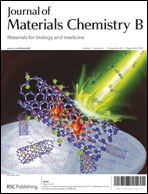Effect of amide hydrogen bonding on spontaneously formed gel-emulsions by two pyridyl carboxylic acid based amphiphiles, sodium salt of 2-dodecylpyridine-5-carboxylic acid and sodium salt of [2-dodecylpyridine-5-carboxylic]glycine: entrapment and release of vitamin B12†
Abstract
The present study offers the demonstration and rational design of two synthesized single chain pyridyl carboxylic acid (nicotinic acid) based amphiphilic gelators named the sodium salt of 2-dodecylpyridine-5-carboxylic acid (SDDPC) and the sodium salt of [2-dodecylpyridine-5-carboxylic]glycine (SDDPCG). The gelation abilities were tested in a series of organic solvents, by a number of physical methods including X-ray diffraction, FTIR spectroscopy, rheology, DSC, optical and electron microscopy. The minimum gelation concentration and gelation number of the gelators in different solvents were determined. No gelation was observed when pure solvents were employed. The gelation properties of these two compounds found that the gelation depends on H-bonding of the amide linkage. X-ray diffraction study indicates the presence of two recognizable morphologies for SDDPC in a gel-emulsion, whereas for SDDPCG a single type of aggregate is predominant. FTIR spectra suggest that the presence of intermolecular hydrogen bonding facilitates the gelation process. Rheological measurements demonstrated that the gel-emulsions are mechanically stable and exhibit typical viscoelastic properties. Optical microscopy images show a network structure in the gel phase and a fibril structure in the xerogel. SEM images confirmed the presence of network as well as a flex-like thick fibrous network for both the amphiphiles, forming three dimensional (3-D) networks. Both the gelators showed a remarkable response toward external pH. The gel-emulsions were used in the controlled and/or pH triggered release of entrapped (within the gel-emulsions) vitamin B12 at different pHs.
![Graphical abstract: Effect of amide hydrogen bonding on spontaneously formed gel-emulsions by two pyridyl carboxylic acid based amphiphiles, sodium salt of 2-dodecylpyridine-5-carboxylic acid and sodium salt of [2-dodecylpyridine-5-carboxylic]glycine: entrapment and release of vitamin B12](/en/Image/Get?imageInfo.ImageType=GA&imageInfo.ImageIdentifier.ManuscriptID=C3TB20970A&imageInfo.ImageIdentifier.Year=2013)

 Please wait while we load your content...
Please wait while we load your content...